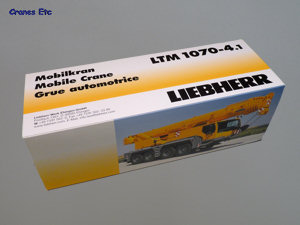 | | The standard Liebherr box sleeve. |  | 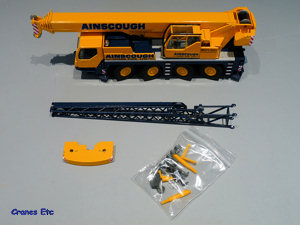 | | The parts out of the box. | 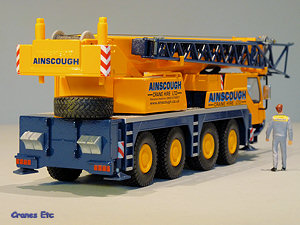 | | Wheel chocks stowed at the rear. | 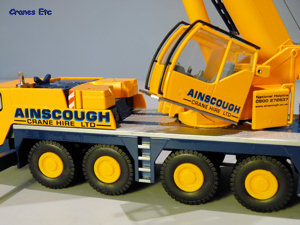 | | Tilting cab in the newer style. | 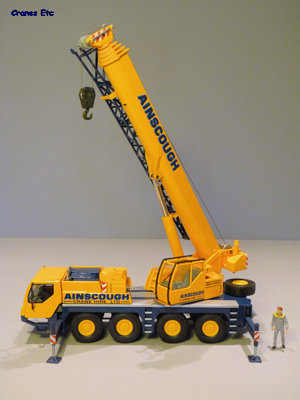 | | With the boom up the crane rotates to pick up the counterweight. | 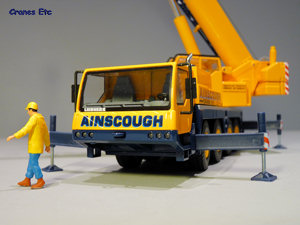 | | Sharp looking driving cab but plastic outrigger beams. | 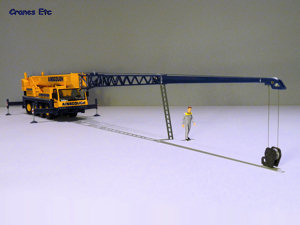 | | The full jib being readied for use. |
| The Liebherr LTM1070-4.1 Mobile Crane is a versatile four axle mobile crane with a maximum capacity of 70 tonnes.
This model was first reviewed in the colours of Mammoet here. This version is in the colours of the UK crane hire company Ainscough. Ainscough is the largest such company in the UK and operates cranes and associated haulage across the whole lifting spectrum up to and including 1000 tonnes. This review is an updated version of the previous review.
Packaging
The crane comes in a typical Liebherr style box although there are no specifications or information about the real machine. Inside the box the model is held tightly within a two piece expanded polystyrene tray. Small parts are supplied in a plastic bag tucked into the box. The review model was undamaged and had no missing parts.
As is often the case with a model of this type there are no instructions provided although it is obvious where the parts go and a novice would only take a little time to figure it out.
Detail
Looking at the carrier first, underneath there is really no chassis detailing at all and the model is purely functional. The tyres and wheel hubs are the standard Conrad variety and are perfectly good although on the real machine axle 2 is not driven so has a different hub to the other axles.
The driving cab has some detailed headlights, a loop for attaching the hook during transport and also wing mirrors. It is a little surprising that there are no orange beacon lights. Inside, the cab has major features represented.
The carrier deck has a good mixture of cast in details including textured walkway surfaces, and steps to enable access on to the deck. There is also a detailed exhaust and fuel tank, and a spare wheel is attached at the rear. At the back, wheel chocks are provided and there are painted lighting clusters. Outrigger beams are plastic as are the outrigger pads.
The operator's cab is updated from the Mammoet version previously reviewed, and features the same cab design as found on the Liebherr LTM1200-5.1 model. The crane cab is typically Conrad - effective but not laden with detail. The grab rails are plastic and inside the cab the controls and computer screen are modelled. The rest of the crane body is uncluttered. At the rear the counterweight ballast is in two with one piece fitted as part of the superstructure, and has the Liebherr name raised as part of the casting which is a quality touch. The second piece is a detachable block which although solid is cast to represent two separate plates. It is held in place by two plastic lift cylinders with screwed ends. Unfortunately these are straight from the earlier LTM1060 version of the model and are not present on the real crane. As a minimum they should have been halved in length to make them less visible.
The boom is also simply detailed with the mid boom cable drum not modelled and the boom cross section is not quite faithful to the original 'oviform' design on the upper sides. It is a six section telescope. At the boom head the pulleys are plastic but disappointingly not separate as they are in moulded pairs which restricts their ability to run freely with a multi line hook.
The fly jib lattice section is a very good casting. It connects to the boom head via the usual pin system although on this version they are plastic rather than metal. It attaches to the boom side with removable plastic brackets. The swing away jib section appears to be plastic but looks good nonetheless.
To complete the model a metal hook block is provided which has a single plastic set of three pulleys so again free running of the hoist rope cannot occur. The block only has a single hook which is better than the double hook issued with some versions of the model.
Features
Steering of the axles is very good. They operate in linked pairs so all the modes of the original machine can be replicated and an excellent hard lock can be obtained.
All the usual crane functions can be carried out and this makes the model great for displaying in different ways. The winch can be operated by turning the serrated edge of the drum with a finger which works fine although it is not comfortable on the finger for long.
The crane cab can be tilted and the counterweight can also be removed by unscrewing the dummy lifting cylinders. It stows very well on the carrier deck and looks realistic in transport mode.
The fly jib can be fixed and operated in folded and unfolded modes although it cannot be offset at an angle as can the original.
Quality
Conrad have a produced another model which is typical of their standards. It is well engineered, with a high standard of casting and the paintwork and graphics on this Ainscough version of the model is very good.
It is a heavy model for its size, with limited use of plastic.
Price
The model is good value in its Liebherr colours for the quality offered. This Ainscough version is rarer and more expensive.
Overall
Collectors in the UK particularly will be pleased to have this Ainscough version of the model in their collection as it is a quality Conrad product. The model design is a few years old and is not as detailed as some of the more recent models being produced. Despite this, the model is recommended. It looks very sharp in the Ainscough livery and hopefully more models will be produced in this colour schame.
Footnotes
The model first appeared at the Nuremberg Toy Fair in February 2006 and was the successor to the Liebherr 1060/2 (Conrad 2094). It appeared at retailers in August 2006. A version in Mammoet colours appeared in 2006. In December 2007 minor amendments were made to the model. The crane cab was replaced with a later version from the LTM1200, a Liebherr flag was added and the hook block has twin hooks. This Ainscough version was commissioned in 2008 in a run of 100 models.
|
| |
| 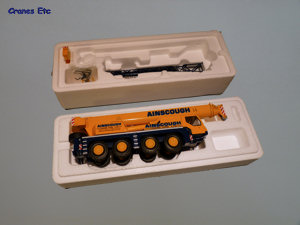 | | Inside the box. | 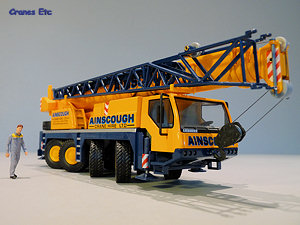 | | It looks great in Ainscough colours. | 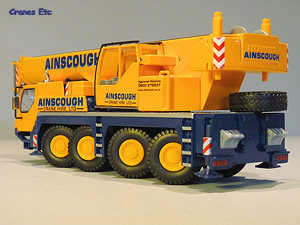 | | The crane with crab steering simulated. | 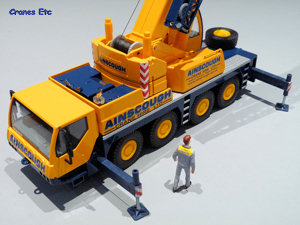 | | Picking up the counterweight and nearly ready for work. | 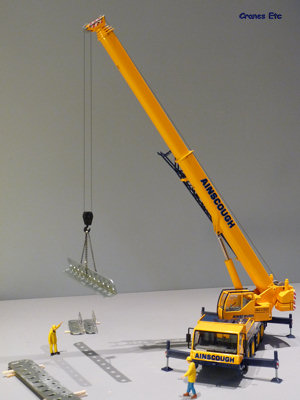 | | At work with the Cranes Etc crew lifting 'beams'. | 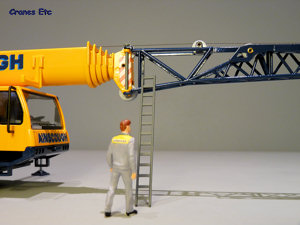 | | Fixing the fly jib. The ladder was purloined from an LG1550. | 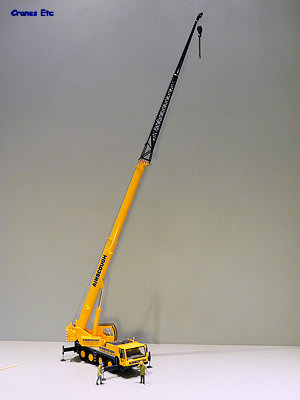 | | Telescoped out on only one section, the crane already reaches a good height. |
|

